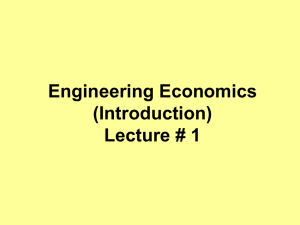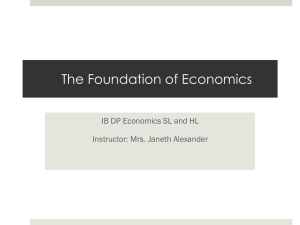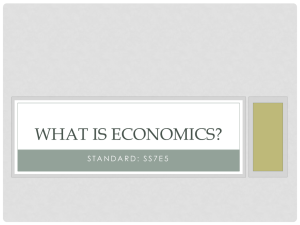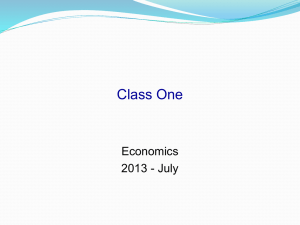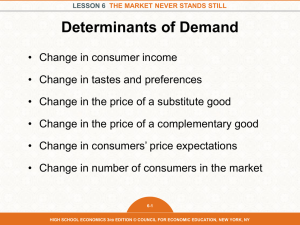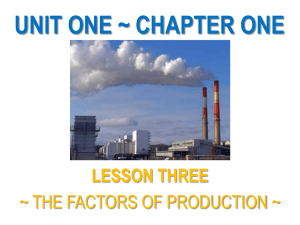Introduction To Economics
advertisement
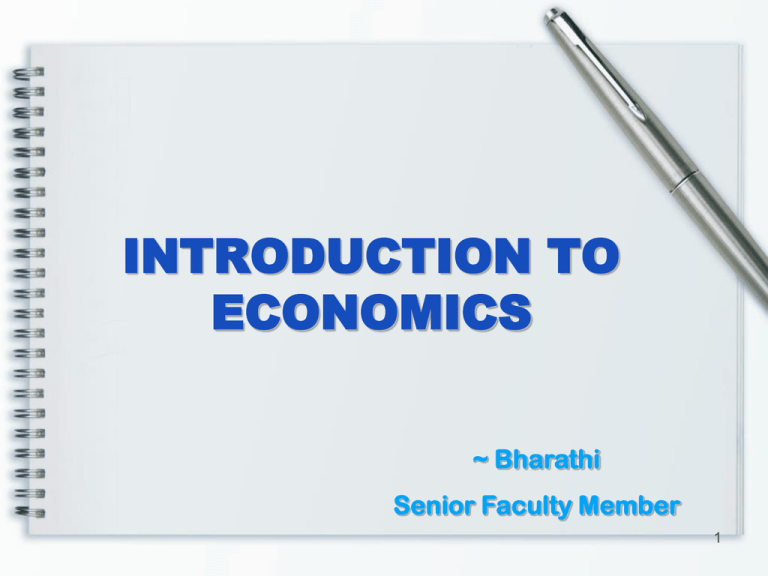
INTRODUCTION TO ECONOMICS ~ Bharathi Senior Faculty Member 1 What is Economics? 2 What is Economics? • A social science that studies and influences human behavior • Economics is the study of what constitutes rational human behavior in the endeavor to fulfill needs and wants. 3 The Foundation of Economics The “Father” Adam Smith (1723 - 1790) – Author of the famous book "An Inquiry into the Nature and Causes of the Wealth of Nations" 4 The Foundation of Economics • Scarcity - Robbins – Scarcity refers to our limited resources and our unlimited wants and needs. – For an individual, resources include time, money and skill. – For a country, limited resources include natural resources, capital, labour force and technology. 5 Needs - Wants. • Human wants are unlimited. • We live in a world of limited resources. • The above leads to scarcity. • People try to balance needs and wants. 6 ECONOMICS MICRO MACRO 7 Micro Economics • Micro Economics studies how the individual parts of the economy make decisions to allocate limited resources • Microeconomics studies: – how individuals use limited resources to meet – – – – – unlimited needs the consequences of their decisions the behaviour of individual components like industries, firms and households. how individual prices are set what determines the price of land, labour and capital inquire into the strengths and weaknesses of the market mechanism. 8 Macro Economics • • • • Macroeconomics studies about the functioning of the economy as a whole It examines the economy through wide-lens. Macroeconomics studies about • the total output of a nation • the way the nation allocates its limited resources of land, labor and capital • the ways to maximize production levels • the techniques to promote trade After observing the society as a whole, Adam Smith noted that there was an "invisible hand" turning the wheels of the economy: a market force that keeps the economy functioning. 9 The Factors of Production Land Labour Capital Organization Product 10 11 ECONOMY MARKET COMMAND MIXED 12 Market Economies In a pure market economy there is no government involvement in economic decisions. 13 Contd…. The Government lets the market answer the following three basic economic questions: 1. What ? Consumers decide what should be produced in a market economy through the purchases they make. 2.How ? Production is left entirely up to businesses. Businesses must be competitive in such an economy and produce quality products at lower prices than their competitors. 3.For whom ? In a market economy, the people who have more money are able to buy more goods and services. 14 Command Economies In a command economy the Government takes economic decisions. Contd…. 15 Command Economies In a command economy the Government answers the three basic economic questions. 1. What? A central planning committee decides what products are needed. 2. How? Since the Government owns all means of production in a command economy, it decides how goods and services will be produced. 3. For Whom ? The Government decides who will get what is produced in a command economy. 16 Mixed Economies In the Mixed economies the Government and the Market work together in decision making 17 Contd… The Economic Problem • • • • Unlimited Wants Scarce Resources – Land, Labour, Capital Many Uses of Resources Choices 18 The Economic Problem • What goods and services should an economy produce? – should the emphasis be on agriculture, manufacturing or services, should it be on sport and leisure or housing? • How should goods and services be produced? – labour intensive, capital intensive? • Who should get the goods and services produced? – Even distribution? More for the rich? For those who work hard? 19 What is Utility? • Satisfaction • Can not be measured – Marshall – Utility can be measured in Utils 20 What are kinds of Utility? Form Utility Place Utility Time Utility 21 Form Utility • In what form is a product available – Whole chicken – Chicken parts – Cooked chicken • Value at each step is different 22 Place Utility • The place where is a product available • Convenience 23 Time Utility • When is a product available 24 Rational Behavior • People know what they want • Their behaviors are consistent with what they want • Assume that the market information is given. 25 Opportunity Cost Definition – the cost expressed in terms of the next best alternative sacrificed The cost of anything in terms of other things given up or sacrificed. 26 Production Possibility Frontiers • PPF Shows the different combinations of goods and services that can be produced with a given amount of resources • No ‘ideal’ point on the curve • Any point inside the curve – suggests resources are not being utilised efficiently • Any point outside the curve – not attainable with the current level of resources • Useful to demonstrate economic growth and opportunity cost 27 Production Possibility Frontiers If it devotes all Capital Goods Ym Yo A country Assume a its is IfIf it the reallocates resources to resources (moving at point A onitthe country can capital round thegoods PPF from A PPF It can produce two could produce a to B) it can produce produce the types of goods maximum of Ym. more consumer goods but onlyits at the expense combination of Yo with If it devotes all its of fewer capital goods. capital goods and resources – resources to cost of The opportunity Xo consumer capital goods consumer it – producing angoods extra Xo goods and consumer X1 consumer goods could produce a is Yo – Y1 capital goods maximum of goods. Xm B Y1 Xo X1 Xm Consumer Goods 28 Production Possibility Frontiers A It can only produce atProduction points outside the PPF if it finds inside thea way ofPPF expanding – e.g.its resources or point Bthe improves means the productivity of those resources already countryit is not has. This will push using all its the PPF further resources outwards. Xo X1 Consumer Goods Capital Goods C Y1 Yo . B 29 Principles of Economics 30 HOW DO PEOPLE MAKE DECISIONS? 31 1. People face trade-off • Every decision involves choices, and more of one good means less of another good. Trade-off applies to individuals, families, corporations and societies. • Trade off between Efficiency and Equity — Efficiency means the society is getting maximum benefits from its scarce resources(Size of the economic pie) — Equity means the distribution of the benefits among the members of the society equally (How the pie is divided) 32 2. Cost of something is what you give up to get it • When we make a decision we compare the costs and benefits of our choices. • Opportunity cost is whatever must be given up to obtain something. • People compare costs and benefits 33 3. Rational people think at the margin • Basic economics assumes that people act rationally • They try to act so as to gain the most benefit compared to the costs • Microeconomics focuses on small or marginal changes • Economists use the term marginal changes to describe small incremental adjustments to an existing plan of action • Rational people often make decisions by comparing marginal benefits and marginal costs 34 4. People respond to incentives • If rational people compare costs and benefits, then changes in either one may change decisions. • An incentive is something that induces a person to act . • An example of an incentive is that, people respond to changes in prices. In general, people are more likely to buy something if it is cheaper. If an action becomes more costly, then there is an incentive to switch to other choices. Note that all actions have substitutes. 35 HOW PEOPLE INTERACT? 36 Trade makes everyone better off • Trade between two countries can make each country better off • Trade allows each person to specialize in the activities he or she does best, whether it is farming or home building • Trade with others enables people to buy a variety of goods at lower cost • Countries as well as families benefit with the ability to trade with one another • Trade allows countries to specialize in what they do best and to enjoy greater variety of goods 37 Markets are usually a good way to organize economic activity • Firms decide whom to hire and what to make • Households decides which firms to work for and what to buy with their incomes • These firms and households interact in the market place, where prices and self interest guide their decisions 38 39
